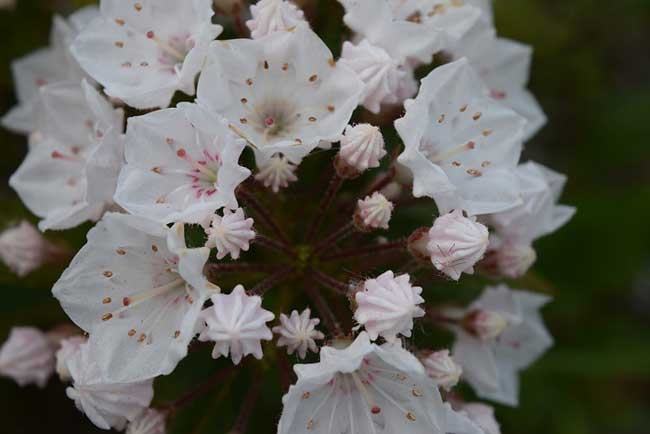
A Brief History of Pennsylvania's State Flower
The state of Pennsylvania is often associated with the large metropolitan areas of Pittsburgh and Philadelphia. However, this state has more to offer than just bustling cities. Pennsylvania is rich in rugged landscapes, including the Appalachian Mountains and sprawling state forests. Pennsylvania is also full of farms, and an expansive Amish community calls this state home. The mountain laurel has been the state flower of Pennsylvania since 1933.
The mountain laurel is actually an evergreen shrub, exhibiting pink and white flowers in the shape of five-point stars. Mountain laurel is a broad-leaf plant that grows natively in Pennsylvania. The glossy, dark green leaves do not fall off the shrub during the winter. All green parts of the shrub are poisonous to humans and animals: With ingestion, a burning sensation occurs almost immediately, followed by nausea, abdominal pain, low blood pressure, weakness, convulsions, paralysis, coma, and possibly death.
Mountain laurel is prevalent throughout eastern North America between southern Maine and northern Florida. Species of mountain laurel vary in size, with some growing as tall as 40 feet. Most of the shrub varieties reach heights of between four and 10 feet, however. It's common for mountain laurel to cover the foothills and even the peaks of the Appalachian Mountains during late spring and early summer. Mountain laurel needs acidic soil and good drainage, and it also needs indirect sunlight for the best blooms. The shrub grows at a shallow depth, and it appreciates pine bark compost mixed into the soil, which enhances soil acidity. Mountain laurel doesn't grow well in wet or heavy soil. If you're growing mountain laurel at home, it's important to deadhead the spent flowers often to keep the plant healthy.
Mountain laurel blooms from late May into mid-June in Pennsylvania. Tourists in the know will flock to Pennsylvania during this time to enjoy not only the splendorous beauty of the pink and white flowers but also their heady scent. The bell-shaped blossoms are about an inch in diameter with pointed petals that resemble stars. The contrast between the white or light pink petals and rosy colored pistils and stamens makes the mountain laurel flowers breathtakingly beautiful. The stamens in the blossoms arch, and the tips sit just under the rims of the petals. When a pollinator such as a bee or a butterfly lands on a blossom, the weight causes the stamen to separate from the petal, which releases pollen into the air like a catapult.
On May 5, 1933, Pennsylvania Gov. Gifford Pinchot signed a bill to make the mountain laurel the state flower of Pennsylvania. It's said that the governor's wife found the mountain laurel plants delightful, leading her husband to choose it to be the state's official flower. At the time, there were two bills competing with different flowers nominated for this honor. Pinchot opted to make the mountain laurel the state flower instead of the pink azalea.
Some people know mountain laurel as calico bush, sheep laurel, ivybush, spoonwood, lambkill, or clamoun. Mountain laurel's scientific name is Kalmia latifolia. The genus name was chosen to honor Pehr Kalm, who was sent to North America by the Swedish government in 1748 to report on the natural resources there. Mountain laurel is in the Ericaceae or heath family, which also includes blueberries, cranberries, azaleas, and rhododendrons. Mountain laurel's division is Tracheophyta, the class is Magnoliopsida, the order is Ericales, and the genus is Kalmia. Plant breeders have created new cultivars in varying sizes with different colored blooms. Some leaves are narrower, and some flowers are a more coral or reddish-pink in color. Some blossoms are also shaped differently. Some of the names of the different cultivars include "Bullseye," "Carousel," "Comet," and "Heart's Desire."
Although the blossoms only last for a few weeks in late spring and early summer, the green leaves and dense growth of mountain laurel make this shrub beautiful throughout the seasons. The stems and branches grow in a circling and gnarly fashion, giving the shrubs lots of character and interest. Some people even like to use the wood to make furniture and other woodworking projects. Interestingly, as the state flower of Pennsylvania, mountain laurel does not have special protections. Although you can't remove any plants from public or private lands without permission, some people like to grow it themselves to harvest for woodworking projects. When you find mountain laurel growing in the wild, you're sure to enjoy it during any season of the year.
This article was published by Chad Kremp



